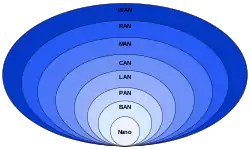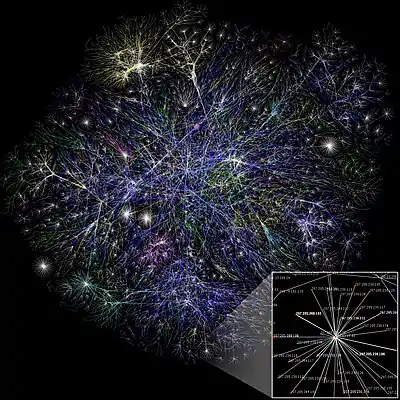Telecommunications network
A telecommunications network is a group of nodes interconnected by links that are used to exchange messages between the nodes.[1] The links may use a variety of technologies based on the methodologies of circuit switching, message switching, or packet switching, to pass messages and signals. For each message, multiple nodes may cooperate to pass the message from an originating node to the a destination node, via multiple network hops. For this routing function each node in the network is assigned a network address for identification and locating it on the network. The collection of addresses in the network is called the address space of the network.
| Network science | ||||
|---|---|---|---|---|
| Network types | ||||
| Graphs | ||||
|
||||
| Models | ||||
|
||||
| ||||
|
||||
Examples of telecommunications networks include computer networks, the Internet, the public switched telephone network (PSTN), the global Telex network, the aeronautical ACARS network, and the wireless radio networks of cell phone telecommunication providers.[2]
Network structure
In general, every telecommunications network conceptually consists of three parts, or planes (so called because they can be thought of as being, and often are, separate overlay networks):
- The data plane (also user plane, bearer plane, or forwarding plane) carries the network's users' traffic, the actual payload.
- The control plane carries control information (also known as signaling).
- The management plane carries the operations and administration traffic required for network management. The management plane is sometimes considered a part of the control plane.
Data networks
| Computer network types by spatial scope |
|---|
 |
Data networks are used extensively throughout the world for communication between individuals and organizations. Data networks can be connected to allow users seamless access to resources that are hosted outside of the particular provider they are connected to. The Internet[3] is the best example of many data networks[1] from different organizations all operating under a single address space.
Terminals attached to IP networks like the Internet are addressed using IP addresses. Protocols of the Internet protocol suite provide the control and routing of messages across the and IP data network. There are many different network structures that IP can be used across to efficiently route messages, for example:
- wide area networks (WAN)
- metropolitan area networks (MAN)
- local area networks (LAN)
- Internet area networks (IAN)
- campus area networks (CAN)
- virtual private networks (VPN)
There are three features that differentiate MANs from LANs or WANs:
- The area of the network size is between LANs and WANs. The MAN will have a physical area between 5 and 50 km in diameter.[3]
- MANs do not generally belong to a single organization. The equipment that interconnects the network, the links, and the MAN itself are often owned by an association or a network provider that provides or leases the service to others.[3]
- A MAN is a means for sharing resources at high speeds within the network. It often provide connections to WAN networks for access to resources outside the scope of the MAN.[3]
Datacenter networks also rely highly on TCP/IP for communication across machines. They connect thousands of servers, are designed to be highly robust, provide low latency that is typically up to hundreds of microseconds, and high bandwidth. Datacenter network topology plays a significant role in determining the level of failure resiliency, ease of incremental expansion, communication bandwidth and latency.[4]
Capacity and speed
In analogy to the improvements in the speed and capacity of digital computers, provided by advances in semiconductor technology and expressed in the bi-yearly doubling of transistor density, which is estimated by Moore's law, the capacity and speed of telecommunications networks has followed similar advances, for similar reasons. In telecommunication, this is expressed in Edholm's law, proposed by and named after Phil Edholm in 2004.[5] This empirical law holds that the bandwidth of telecommunication networks doubles every 18 months, which has proven to be true since the 1970s.[5][6] The trend is evident in the Internet,[5] cellular (mobile), wireless local area networks (LANs), and personal area networks.[6] This development is the consequence of rapid advances in the development of metal-oxide-semiconductors (MOSFET).[7]
References
- "Design Elements - Telecommunication networks". Archived from the original on 2014-07-14. Retrieved 2014-07-14.
- "Telecommunication Network - Types of Telecommunication Networks". Archived from the original on 2014-07-15. Retrieved 2014-07-14.
- "Metropolitan Area Network (MAN)". Erg.abdn.ac.uk. Archived from the original on 2015-10-10. Retrieved 2013-06-15.
- Noormohammadpour, Mohammad; Raghavendra, Cauligi (28 July 2018). "Datacenter Traffic Control: Understanding Techniques and Tradeoffs". IEEE Communications Surveys & Tutorials. 20 (2): 1492–1525. arXiv:1712.03530. doi:10.1109/COMST.2017.2782753.
- Cherry, Steven (2004). "Edholm's law of bandwidth". IEEE Spectrum. 41 (7): 58–60. doi:10.1109/MSPEC.2004.1309810.
- Deng, Wei; Mahmoudi, Reza; van Roermund, Arthur (2012). Time Multiplexed Beam-Forming with Space-Frequency Transformation. New York: Springer. p. 1. ISBN 9781461450450.
- Jindal, Renuka P. (2009). "From millibits to terabits per second and beyond - Over 60 years of innovation". 2009 2nd International Workshop on Electron Devices and Semiconductor Technology: 1–6. doi:10.1109/EDST.2009.5166093. ISBN 978-1-4244-3831-0.
